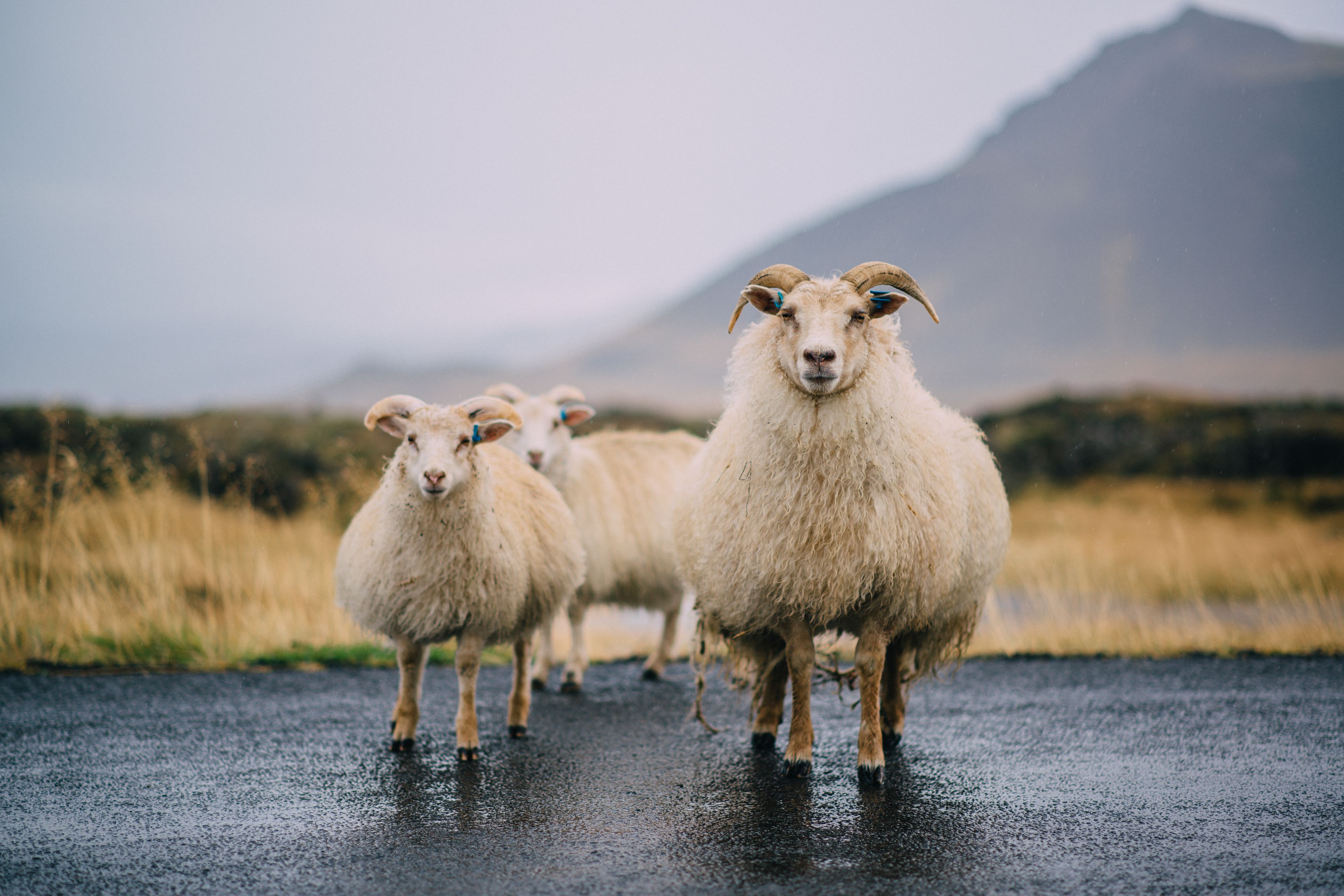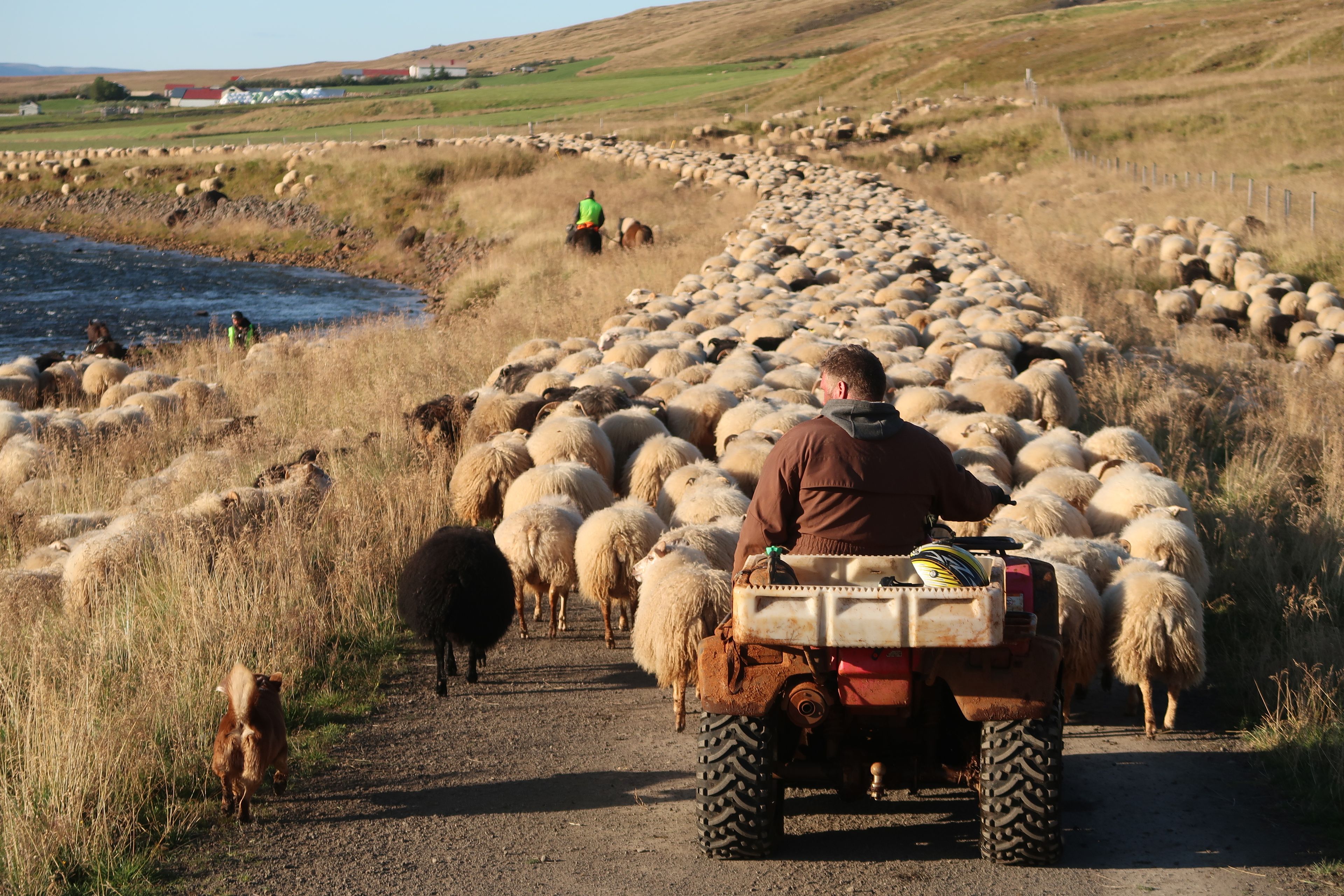
Iceland's réttir: Sheep roundup
Jump to chapter
Every Spring after lambing season, over 800,000 Sheep roam the Icelandic countryside. Farmers allow their flocks to be in a free range, allowing them to chow down on all of the lush landscape freely for the summer. Then in the early fall, the Sheep are rounded up and collected by the farmers. This day turns into a town party! Keep reading to learn about Iceland’s primary animal and how they are rounded up each year.
Why Sheep Are Important
They have played a key role in Icelandic history over time. First of all, there are more sheep in Iceland than there are people. How crazy is that? When settlers came to Iceland in the 9th and 10th centuries sheep became their right-hand animal. They were used for milk production until the 1940s.
This was due to cows being very expensive during that time. So sheep were the frontrunners for milk. Throughout the years they were used as a food source especially when food was scarce in the early times of Iceland.
What type of Sheep are in Iceland? You will find Northern short-tailed sheep which are the largest in their breed. The sheep descend from the similar breed of Norwegian Spelsau. Back in the day, farmers tried to cross-breed sheep too.
This did not end well as it made them prone to diseases. Most of these Sheep had to be put down due to their illnesses. After that, they were purebred only, which helped their lifespan. Since they were around for thousands of years they naturally adjusted to the Icelandic weather. Which at times, can be very harsh.
Sheep play an important role in the economy of Iceland. While some sheep are used for food, others are used for wool. Some are even kept strictly for breeding. It is said that 80% of income from farming sheep is from selling them.
Many Icelandic dishes, including traditional ones, include sheep. Ranging from lamb chops and the infamous sheep head. You can read about that bizarre dish in our Traditional Icelandic Food blog.
Iceland’s hot dogs are primarily made of lamb instead of beef as well. Lamb soup is another common dish you will find on restaurant menus. It is quite the delicacy in the cold winter months too.

Wool is another predominant purpose of Sheep in Iceland. There are plenty of different places to purchase wool throughout the country. Whether you want a souvenir to take home or just a cozy sweater for your trip. KIDKA Wool Factory Shop is located in Hvammstangi, Iceland. A wool hot spot!
KIDKA stands for beautiful and high-quality knitwear that is both fashionable and comfortable to wear and is 100% made in Iceland. They are their own knitting and sewing factory that produces clothing made from pure Icelandic wool. You can even take a factory tour here to get an up-close and personal view. Or just simply stop by the factory to purchase some authentic wool items.
Álafoss is a historic wool store that dates back to 1896. It was the true beginning of Iceland's wool industry. The original factory building is still being used today as the home of the Álafoss wool store, in the Álafosskvos in Mosfellsbær.
Their wool sweaters are the absolute show-stopper. They are made with authentic Icelandic wool that is hand-knitted in Iceland. They even mark the sweaters with the knitter's name. Wool blankets, yarn and so much more are sold here. The store is a quick fifteen-minute drive from Reyajvik to, making it a convenient stop during your next Iceland road trip.
Réttir
Now let’s talk about the sheep round-up. Once a year in September, Réttir takes place. This is a national rounding up of the free-roaming sheep. You can herd them by foot, horses, sheepdogs, or even ATVs.
Once the sheep are rounded up it is time to separate them into wooden pens. This is where the farmers separate the herd. The sheep have tags on their ears which lets us know which farmer they belong to. This part of Réttir can take days, especially in stormy and wet weather. However, it remains a group effort that brings the community together.
So how do you know where to go for this event?
They are normally held at different farms throughout the Icelandic countryside. The newspaper will publish a list closer to the event each year. Be sure to keep a lookout in the summer for when and where the events will take place.
So, you only need to rent a car and head to your destination, as tourists are encouraged to join and help with this process. Tourists are encouraged to join and help with this process. A truly unique experience that helps the local farmers when visiting Iceland.

Réttaball
Even though Réttir is very hard work it is also a time to gather. Icelanders and tourists come together for a celebration during this time. This is called Réttaball and it is a way to reward each other for all of their time and effort. The festival includes a night full of fun, including folk dancing and singing. There is a delicious feast served up as well.
Lamb, sheep's head, and mutton are featured on the menu, for obvious reasons. A celebration wouldn’t be complete without drinking the famous “Black Death”. Also known as Brennivín, a famous Icelandic beverage.
Réttir is such a beneficial event for the country. It allows farmers to see the outcome of their efforts made throughout the year with the sheep. It also teaches younger generations the importance of hard work. It truly takes an army to pull off Réttir, which is why the after-party is completely necessary.
Did you know there is a Mountain King that is in charge at Réttir? This chosen person, also known as Fjallkóngur, will lead the group of people across the valley and up mountains. This way everyone is safe when rounding up the sheep.
You can even meet one of the Mountain Kings by watching our episode of Iceland Is Weird But So Great #5 Sheep Round Up. Follow Bjarnfreður & Family, Hermigerfill, Rafael Pinho, and other locals on their sheep round-up journey!
As you embark on a journey through the vibrant culture and storied history of Iceland, the striking image of the Iceland flag emerges as a poignant symbol of national pride. With its bold blue hues and the iconic cross motif, the flag encapsulates the essence of Icelandic identity and resilience. Whether fluttering majestically in the wind at official gatherings or adorning buildings during festive occasions, the Iceland flag serves as a powerful reminder of the nation's rich heritage. For a deeper understanding of the symbolism and significance behind the Iceland flag, delve into Go Car Rental's illuminating guide: Icelandic Flag.
Latest Blog Posts
 Canyons
CanyonsMúlagljúfur Canyon: A Secret in South Iceland Waiting to Be Explored
Iceland is a country packed with amazing natural monuments. They can be found in every corner of the country, but certain regions are especially full of these wonders. And, without a doubt, South Iceland has a lot to see and do. Many of the most famous national landmarks are located in this part of the Island, and some are well-known worldwide. However, there are still a few places that not many people, apart from the locals, know and that don’t usually appear on travel guides. If you’re looking for one, then you’re in luck. Múlagljúfur Canyon sits here, a stunning escape for travelers ready to explore beyond the usual stops. This rugged gorge, with its waterfalls crashing down mossy cliffs, showcases the rawest side of Iceland like few others. Away from the busy tourist trails, it offers crisp air, dramatic views, and a peaceful vibe that’s hard to resist. If you’re up for a hike and eager to uncover a lesser-known gem, Múlagljúfur is calling your name.
 Wildlife
WildlifeDiscover the Wings of Iceland: A Birdwatching Guide
Iceland is a country primarily known for its variety of landscapes. Here, the powerful forces of nature have created an astonishingly high number of natural monuments that often leave visitors speechless. For that reason, in recent years, many adventurers have chosen this island in the middle of the Atlantic Ocean as a destination. But the attractions this Nordic gem has don’t end there. There are many other reasons to discover what Iceland has waiting for you, such as a fascinating culture and great wildlife. And in the latter, Iceland is a prime place for bird watching. This island is a sanctuary for a large number of species that nest, migrate, or live here year-round. With so many different habitats present in the country, Iceland offers unparalleled birdwatching opportunities. Come with us and learn what the most sought-after birds are and where to find them.
 Places to Visit
Places to VisitGrótta Lighthouse: A Magical Place Near Reykjavik
Iceland has plenty of cool spots to visit, but some of the best ones fly under the radar. Grótta Lighthouse is one of these hidden gems – a charming lighthouse on a tiny tidal island with amazing views, lots of birds, and one of the best places near Reykjavík to see the Northern Lights. Unlike the busy tourist hotspots, Grótta lets you experience Iceland's raw nature just minutes from the capital. Here's the catch: You can only reach it at low tide, which makes getting there part of the adventure. Let's look at everything you need to know to plan a great visit to this coastal treasure.
